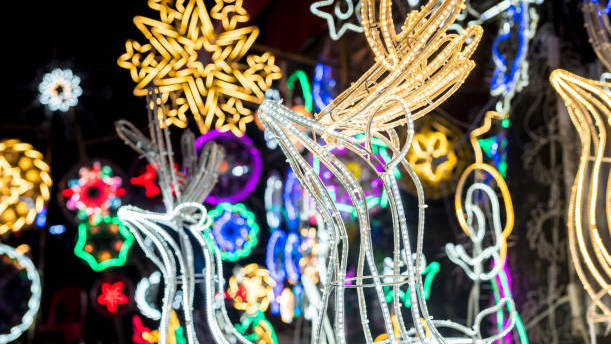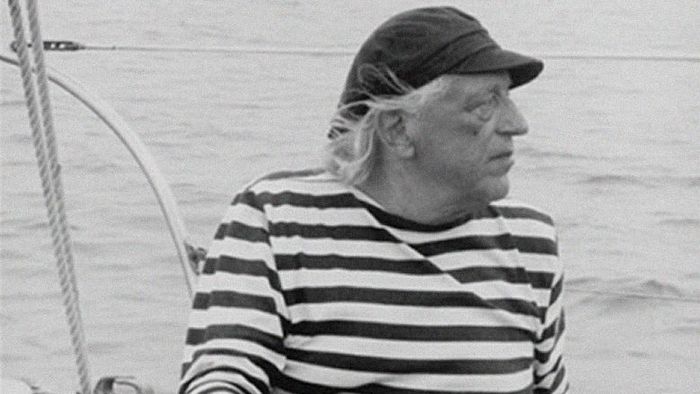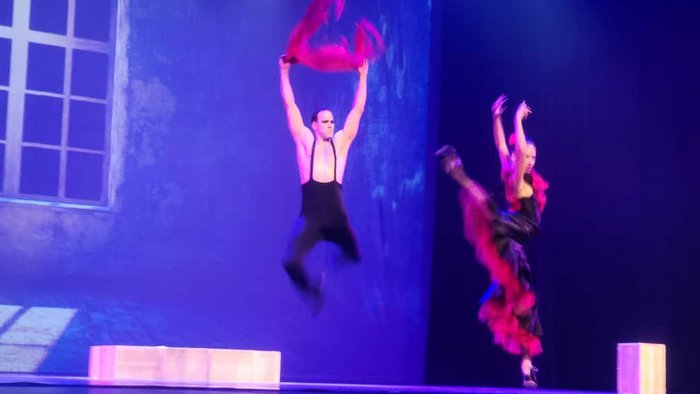Rethinking art-audience relations in recent Caribbean Art
"Responsibility, as the etymology of the word reminds us, is structurally intersubjective.
Without anybody to whom to answer to, that is, without someone demanding an answer, challenging us with their claim, there is no possible responsibility”
Manuel Cruz[i]
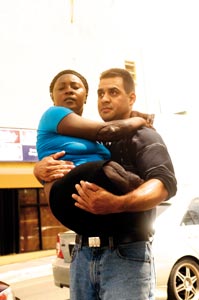 In 2010 the artist David Perez, Karmadavis, devised an action in which a blind Dominican carried on his shoulders a handicapped Haitian woman through the streets of Santiago de los Caballeros, Dominican Republic. Both of them would have to wade through urban chaos. The documentation of the performance shows how the team was fully integrated into the landscape, engaged in cooperation as the only manner to overcome the obstacles in their way, while pedestrians go about with their daily practices.
In 2010 the artist David Perez, Karmadavis, devised an action in which a blind Dominican carried on his shoulders a handicapped Haitian woman through the streets of Santiago de los Caballeros, Dominican Republic. Both of them would have to wade through urban chaos. The documentation of the performance shows how the team was fully integrated into the landscape, engaged in cooperation as the only manner to overcome the obstacles in their way, while pedestrians go about with their daily practices.
The couple not only had to adapt their situation, their position in motion, to the conditions of the elements that they met; but at the same time their presence forced passersby to readjust their passage. It’s all about a symbiotic relationship in which the artist has altered the coexistence conditions of the city, while forcing the community to rethink the perception of its role in creating living spaces.
The piece that David Perez presented at the xxiii edition of the Leon Jimenes Competition, celebrated in the same Dominican city, is important for several reasons. First, it compels us to think about Haiti-Dominican Republic relations in an eminently practical point of view, distanced from any and all celebratory rhetoric and of all exaggerated affection. It avoids the will of symbolizing a flag to focus on the present, on a more constructive and less categorical experience. The artist, rather, presents a state of affairs in which progress is only possible through dialogue and cooperation, a position that respects the difference, but that places it in the context of a shared reality. On the other hand, it is appropriate to have in mind that the performance, entitled Estructura complete (Complete Structure), raises emphatically one of the axis on which some of the most interesting of contemporary Caribbean creations are centered: the art-audience relationship. The route followed by the couple thus becomes, a path marked by negotiations and more space for dialogue as well as greater openness and effectiveness in the insertion of social issue speeches. Thus, the material available to Karmadavis expands until it reaches the entire reality, incidentally providing the possibility of intervening in it.
In recent years Caribbean art practice is dominated by the need to add spaces and seek speakers that can deliver a more effective impact of the work in its context. Collaborative experiences and workshops, as well as the rise of performance trends that have a tendency to question the creator’s responsibility in regards to the whole social affair, have led to a renewal that involves not only adopting new aesthetic assumptions, but a firm commitment by the artists, characterized by the need to expand their scope in other to correct the interruptions present in the context in which they operate.
On the other hand, a much more oblique aesthetic has emerged, which avoids showing its cards and involves a rising awareness of the growing complexity of the Caribbean creator’s position, which has managed to inserted himself into a panorama that covers the entire globe although, referencing the words of Gerardo Mosquera, a work of art must still continue to "present its passport". We speak, therefore, of a panorama that talks in a much more fluid manner with the international context, and that Chris Cozier correctly defined in an exhibition in 2011:
Some of these artists were born in one island and live and work in another. Some are born in the ´Caribbean Diaspora´ and continue to investigate how that shapes their ways of thinking. For them, the Caribbean is also a site of memory, where they process family histories or the vast archives of former colonial powers. They may live in places like Japan, Austria or Germany, not traditionally located in diasporic mappings. Much of their work is inspired by one location, produced in another and presented yet elsewhere. It reflects the way Caribbean people have always been on the move.[ii]
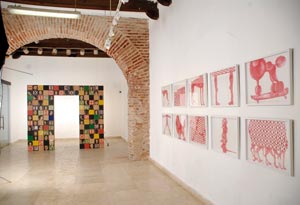 The performance of David Perez took place as part of a contest that had been renovated to highlight the work’s process. Within this logic, in the same event another action could be witnessed, that also established a reflection on the limits and possibilities of creation’s insertion, as well as the renunciation to symbolization. Remando en una lágrima(Paddling on a tear), by Sayuri Guzman, once again outlines the question of space and the geography of his native island, this time closing in on the illegal immigration to Puerto Rico. The piece included a research process in which the artist interviewed people who had made the trip. In that dwelling, Guzman had small scale replica of the boats used built: the "yola" was tested by the artist in open sea for a whole night.
The performance of David Perez took place as part of a contest that had been renovated to highlight the work’s process. Within this logic, in the same event another action could be witnessed, that also established a reflection on the limits and possibilities of creation’s insertion, as well as the renunciation to symbolization. Remando en una lágrima(Paddling on a tear), by Sayuri Guzman, once again outlines the question of space and the geography of his native island, this time closing in on the illegal immigration to Puerto Rico. The piece included a research process in which the artist interviewed people who had made the trip. In that dwelling, Guzman had small scale replica of the boats used built: the "yola" was tested by the artist in open sea for a whole night.
The action segment that took place at the museum space, during the contest, is what completed the work. The vessel was held up two meters from the central hall’s floor by a scaffolding structure, and the artist began to paddle for forty-eight minutes, one minute per each of the hours of the journey through the Mona Channel. A microphone connected her breathing and heartbeat to an audio system that amplified the sound throughout the space, completely sealed to amplify the effect, which got the audience to take part in the experience. The fact that the boat did not move despite the artist’s physical effort avoided any simplistic interpretation of the piece, widening its significance.
This openness, precisely, is shared by the best of the current Dominican artistic activity. Guzman, along with Clara Caminero (Arte-estudio), is responsible for the curatorship of an action performed by Regina Galindo in February 2011 and sponsored by the Spanish Cultural Center of Santo Domingo. In this action, theGuatemalan parks a car that would later be dismantled in record time by a tide of mechanics. In a thorough and meticulous manner, the specialists proceeded to remove every piece of the vehicle until the artist was left standing on the street. As in previous cases, the piece which was meaningfully titled Marabunta, placed the axis of the work in the analysis of the behavior of the masses, in examining the implications of social action and, finally, in thinking about the possibility of the creator’s intervention in the action. Not only from the domain of the performance has this issue been addressed: shows such as Curador Curado(Cured Curator, 2001), pose an answer to the discontinuities that govern the connection between creation, exhibition and institutionalization of Dominican art, to which we must add the difficulty the country’s artists are confronting in entering the international arena. On its own, from a different area, the presentation of the Quintapata Collective, formed by Pascal Meccariello, Belkis Ramirez, Raquel Paiewonsky and Jorge Pineda has focused on creating better conditions for artistic production, a goal that they have sought to extend the rest of the creators of the country through project management and teamwork, in permanent dialogue with the Dominican society.
To assume that area of dialogue as an objective implies, often, the concealment of the artist, who is in this manner included in the device established by the piece itself. In that sense, one of the most dramatic cases was presented by Audry Liseron-Monfils (Guyana) in the Delhi Triennial 1997-1998. In an action entitled Cour d'air he was introduced into a structure hidden in the exhibition space, so that only the top of his head was visible. Immobilized, she became an object, placing the audience that had to interact with a hemisphere whose function and origin were unknown in an awkward position. The work, which included indirect references to the middle passage, also served as a metaphor for the artist's position on the periphery in regards to the international circuit.
In two recent pieces, Joëlle Ferly (Guadalupe) has moved the concern about the place occupied by the audience to the context of the French Overseas Departments. The first action involved the "solidarity" of the artist with the strike the LKP (Liyannaj Kont Pwofitasyon) collective started in 2009 in Guadeloupe, which called for working conditions’ improvement in the Departments. The event surfaced in a context marked by great economic disparities between the small white population and the black majority, which comes from the colonial era. In this context, the artist took advantage of an invitation to be part of an exhibition at the Fondation Clement from Martinique to declare a strike. The really interesting part of the action lay in the place chosen to carry it out: the current art center is located in the middle of a sugar plantation, a tradition that survives due to the production of rum. By means of this act of rebellion, Ferly accepted the rules of the game both artistically as well as those of the political and social situation of the French-speaking Caribbean, while using the own mechanisms of both systems to subvert them.
More recently, in 2011, Ferly required the collaboration of the artistic community and the society of Port-au-Prince to perform an action in which he was placed at the center of the Champ-de-Mars, nerve center of the capital. With a blindfold on, Ferly climbed on a platform were he stayed for 24 hours, slowly turning herself and looking at the scene, marked by the presence of people who were still homeless after their homes had been destroyed by the earthquake in 2010. Before Ferly a crowd began to gather reacting in different manners: blessing her, photographing her, watching over her, cooling her off with water. Soon the piece became a public demonstration-Revolution: Motion of a Body around another body or around its own axis was the ambiguous title of the work, led by a figure who had only observed and which, due to her passivity, had become a zombie. The work played both with the behavior and the expectations of the population; both elements, the immobility of Ferly and her role in the congregation that could gaze at the piece, gave this work a political touch, connecting it with the game of representations and the recovery of stereotypes that had been leading the looks on Haiti after the earthquake.
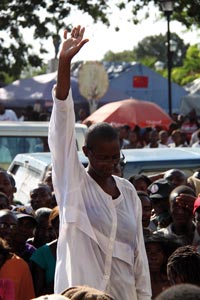 Since the eighties, in Cuba there has been no lack of initiatives that allow us to think that the rules that govern the creation of a space from which the artist interacts with the political area, as well inquiring into the conditions of social mobilization. We confine ourselves here to pointing out some recent examples. Standing out amongst them, no doubt, the much talked about intervention by Tania Bruguera: Los Susurros de Tatlin(Tatlin’s Whispers, Tenth Havana Biennial, 2009), which provided a podium and a microphone from which everyone was offered the opportunity to speak uncensored for a minute, involving the audience in a careful analysis of the flow of information and of the hallowed images. As the artist states:
Since the eighties, in Cuba there has been no lack of initiatives that allow us to think that the rules that govern the creation of a space from which the artist interacts with the political area, as well inquiring into the conditions of social mobilization. We confine ourselves here to pointing out some recent examples. Standing out amongst them, no doubt, the much talked about intervention by Tania Bruguera: Los Susurros de Tatlin(Tatlin’s Whispers, Tenth Havana Biennial, 2009), which provided a podium and a microphone from which everyone was offered the opportunity to speak uncensored for a minute, involving the audience in a careful analysis of the flow of information and of the hallowed images. As the artist states:
This series tries to activate images, known by its recurrence in the press, by de-contextualizing them from the original event that led to the news and staging them as realistically as possible within an art institution. The most important element [...] is the participation of the spectators, who may determine the course the work will take. The idea is that the next time this spectator is faced with a news story using similar images to the one he experienced, he may notice certain empathy [...] towards that distant event and to which he would otherwise normally have an emotionally disconnected attitude or one of information saturation. The experience of the audience [...] allows them to understand the information at another level and to take possession of it because they have lived it.[iii]
At other times, the intervention takes on a playful aura; this is the case of one of the first actions of Alexandre Arrechea, who in Sudor (Sweat) setup a basketball game in Havana in which the outcome was arranged beforehand. In his words:
What I do is organize a basketball game, with neighborhood teams, and while they are playing I'm filming the basket, the hoop, the points, everything that’s happening. Then I take both team’s boards and place screens on the boards. You see the image of the ball coming in, but everything that happened around them was also recorded. Then we setup the loudspeakers so that people could hear all the sounds of what was happening on the street. My work, my project, spoke precisely of participation. In this case, you were in the middle of a game, seeing what was happening, the evolution of the players in the middle of the court, but you realized that you couldn’t change anything at all. You were in a game where you could not modify anything. And let’s say it was like starting to talk again about that social criticism, but from indirect aspects. There was an outer audience, and there was an inner audience, which didn’t participate either, they were merely another spectator.[iv]
A quick glance at that panorama suggests some constants. To begin with, all the pieces speak of an absence to be forcibly completed by the audience. The work also manages to transcend its immediate representation, extending itself through the reactions of the audience and the point of view of its relations with its environment. In this structure, the communicational purpose becomes a basic premise.
However, in all cases the proposed voluntary disappearance the artist proposes introduces a game that transcends directness and locates the work while it’s being opened, which makes it an exchange practice of the current world. The analyzed projects provide a good example of how the Caribbean performance has passed from the ritual to a participatory event. One of the clearest consequences of this change is the development of poetics that emphasize social responsibility and the conditions under which the action occurs, directly involving all the people who witness it. That's when the two senses of that term meet; one which is equivalent to the performing work and the other associated with the event of acting, of carrying out an initiative, in other words, action is "double action". Previously Hans Jonas, in a classic text, spoke of how responsibility was re-signified if considered in a domain that could never be reduced to the immediate environment:
To be sure, the old prescriptions of the “neighbor” ethics –of justice, charity, honesty, and so on– still hold in their intimate immediacy for the nearest, day-by-day sphere of human interaction. But this sphere is overshadowed by a growing realm of collective action where doer, deed, and effect are no longer the same as they were in the proximate sphere, and which by the enormity of its powers forces upon ethics a new dimension of responsibility never dreamed of before.[v]
Through the generation of a structure controlled by the artist himself, areas of dialogue originate with reality whose boundaries with reality are in constant tension, and at the same time succeed in challenging the assumptions that govern the relations of power and knowledge of the civil society. These spaces are also an effective alternative to the "silence zones" generated by the dynamics of economic and political domination that have impact on a global scale.
We do not know, finally, in which direction Caribbean creativity will go the in the coming years. We can, however, be still while we look the path made by the artist, someone engaged in cooperation as the only manner to overcome the obstacles in his way, while pedestrians go about with their daily practices.
[i] MANUEL CRUZ: Las malas pasadas del pasado. Identidad, responsabilidad, historia.
[ii] CHRIS COZIER: “Notes on Wrestling with the Image”. En CHRIS COZIER y TATIANA FLORES (eds.) Wrestling with the Image: Caribbean Interventions,The World Bank, Washington DC, 2011, p.7.
[iii] Página web de la artista http://www.taniabruguera.com.
[iv] Entrevista, 2010.
[v] HANS JONAS: The Imperative of Responsibility. In search of an Ethics for the Technological Age, University of Chicago Press, Chicago, 1984, p.6.

